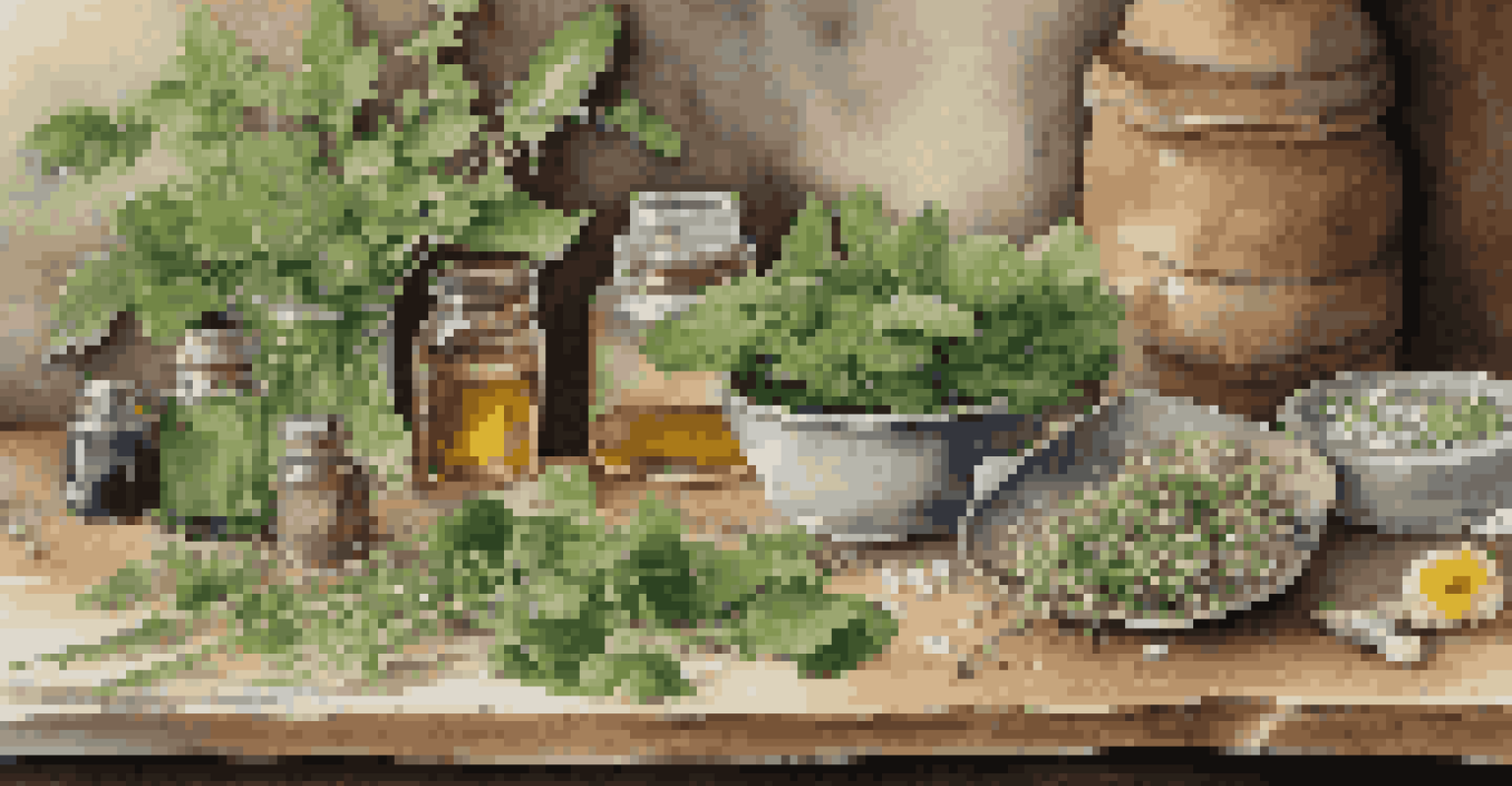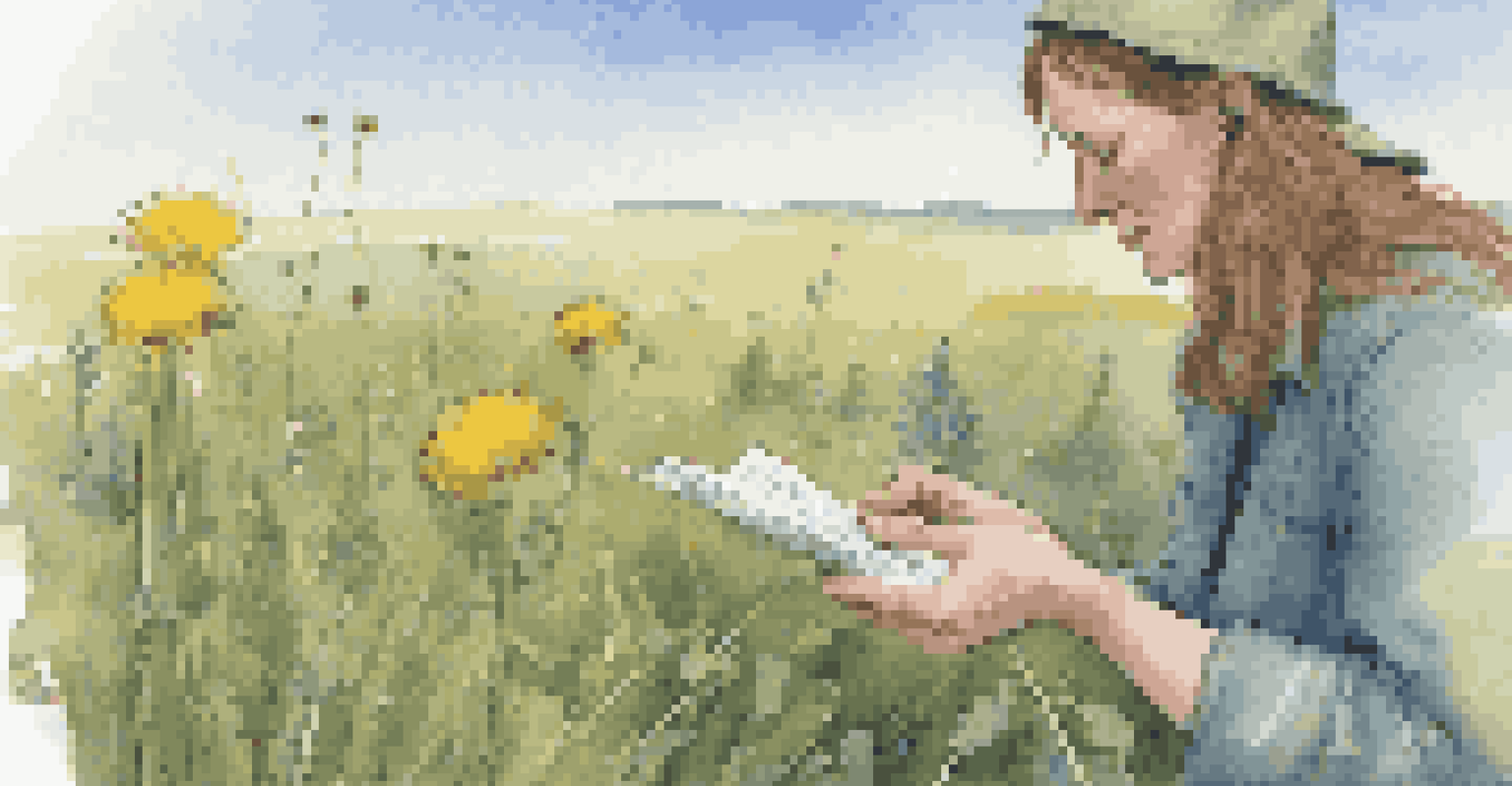Foraging for Medicinal Plants: Nature's Healing Resources

Understanding the Basics of Foraging for Medicinal Plants
Foraging for medicinal plants is the practice of searching for wild plants that can be used for healing purposes. It connects us with nature and allows us to discover the abundant resources around us. Just like learning to cook, foraging requires knowledge, patience, and a bit of adventure.
Nature itself is the best physician.
Before you head out into the wilderness, it’s essential to educate yourself about the plants in your area. Knowing which plants are safe and beneficial can prevent dangerous mistakes. There are numerous guides and apps available that can help identify plants, making the foraging experience both safe and educational.
Additionally, understanding the seasons and habitats of these plants can increase your chances of success. Just as a chef knows when ingredients are at their peak, foragers learn the best times to harvest different plants. This seasonal knowledge helps ensure you’re gathering plants at their most potent.
The Benefits of Using Medicinal Plants
Medicinal plants have been utilized for centuries in various cultures for their healing properties. From soothing common ailments like headaches to aiding in digestion, these natural remedies often offer effective alternatives to over-the-counter medications. They can promote overall wellness while avoiding the side effects associated with synthetic drugs.

Moreover, many of these plants are rich in antioxidants and other beneficial compounds that can boost immunity and fight inflammation. For instance, turmeric is known for its anti-inflammatory properties, while echinacea is often used to stave off colds. Adding these plants to your regimen can be a simple yet powerful way to enhance your health.
Foraging Enhances Nature Connection
Foraging for medicinal plants fosters a deeper appreciation for nature and its healing resources.
Incorporating medicinal plants into your life fosters a deeper connection to nature. This practice encourages mindfulness and appreciation for the environment, reminding us of the natural solutions available to us. The journey to better health can become a personal exploration of nature’s gifts.
Common Medicinal Plants and Their Uses
Several common medicinal plants are easily identifiable and can be found in many regions. For example, dandelion leaves can be used in salads and are known for their liver-supporting properties. Chamomile flowers, often brewed into tea, are famous for their calming effects and can aid in sleep.
The greatest medicine of all is teaching people how not to need it.
Another noteworthy plant is peppermint, which can help with digestive issues and headaches. Its refreshing aroma is not just pleasant; it also has therapeutic benefits. By familiarizing yourself with these plants, you can create a mini-apothecary right in your own home.
However, it’s crucial to ensure proper identification before consuming any plant. Mistaking a harmless plant for a toxic one can lead to serious health risks. Always consult reliable resources or local experts to confirm your findings.
Ethical Foraging Practices to Respect Nature
As you embark on your foraging adventures, it’s important to adopt ethical practices that respect the environment. This means not overharvesting plants and ensuring that you leave enough for wildlife and future growth. A good rule of thumb is to take only what you need and leave the rest.
Additionally, foraging in areas where plants are abundant helps maintain balance in the ecosystem. It’s also wise to avoid harvesting from polluted areas, as plants can absorb toxins from their surroundings. By choosing clean, healthy locations, you ensure that you’re gathering safe and beneficial plants.
Safety is Crucial When Foraging
Proper identification and awareness of surroundings are essential to ensure safe foraging experiences.
Practicing ethical foraging not only preserves the natural habitat but also fosters a deeper respect for the earth. Each forager has a role in maintaining the delicate balance of nature, ensuring that future generations can enjoy its benefits.
Foraging Safety: What You Need to Know
Safety is paramount when foraging for medicinal plants. Always wear appropriate clothing and sturdy shoes, as you may encounter uneven terrain or prickly bushes. A first-aid kit is also a good idea in case of minor injuries during your explorations.
Moreover, be aware of your surroundings. Familiarize yourself with local wildlife, such as snakes or ticks, that could pose a risk. Staying on marked trails and foraging with a friend can help mitigate these dangers.
Lastly, never consume a plant unless you are 100% certain of its identification and edibility. If you’re unsure, consult with an expert or refer to reputable resources. Your health and safety should always come first in your foraging journey.
Transforming Harvested Plants into Remedies
Once you've foraged for your medicinal plants, the next step is transforming them into remedies. Many plants can be dried and stored for future use, while others may be best used fresh. For instance, fresh herbs can be steeped in hot water to create soothing teas, while dried plants can be prepared as tinctures or salves.
Creating your own remedies can be a rewarding experience, allowing you to connect with the plants and understand their properties better. For example, infusing olive oil with calendula flowers can yield a healing salve for minor cuts and scrapes. This hands-on approach not only empowers you but also enhances your appreciation for the healing power of nature.
Ethical Practices Preserve Ecosystems
Adopting ethical foraging habits helps maintain balance in nature and ensures sustainable plant populations.
However, be sure to research proper preparation methods for each plant, as some may require specific techniques to be effective or safe. Learning about these processes can turn foraging into a creative outlet, blending science and art in your kitchen.
Resources for Aspiring Foragers
For those eager to dive into the world of foraging, plenty of resources are available to guide your journey. Books on herbal medicine and local plant guides can provide invaluable information about what to look for and how to use these plants. Websites and foraging communities also offer a wealth of knowledge and support.
Joining a local foraging group or taking a class can enhance your learning experience. These hands-on opportunities allow you to explore with experienced foragers who can share their wisdom and tips. Plus, connecting with like-minded individuals can make the process more enjoyable and rewarding.

Finally, don’t forget about online platforms. Many social media groups and forums are dedicated to foraging, where you can ask questions, share experiences, and learn from others. The more you engage with others in the foraging community, the more confident you’ll become in your skills and knowledge.